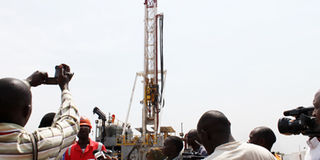Uganda’s oil to cost Shs1,200 per litre

Journalists interview an oil worker at Kigogole Oil well in Buliisa District recently. PHOTO BY ISAAC IMAKA
What you need to know:
Uganda motorists may not necessarily get cheap fuel at the pump come 2016 as production, distribution costs and taxes will push price higher.
Kampala
Uganda’s oil will go for $70 (about Shs185,500) per barrel, the permanent secretary in the Ministry of Energy and Mineral Development, Mr Fred Kabagambe-Kaliisa, has said. He told a group of journalists on Tuesday in Kampala that the ministry had set $70 as a conservative price below which government will not sale its oil. With a barrel having 159 litres, the conservative price means that a litre of Uganda’s crude oil has been set at $0.4 cents (about Shs1,166).
For many Ugandans seeking relief from high fuel prices, this announcement will taper their expectations as it is clear locally produced and refined oil may not necessarily translate into cheap fuel at the pump when taxes and distribution costs are factored in. “We may begin at a point of indebtedness; the cost of paying back the loan [for building refinery] will eat into the cost of production hence driving the cost at the pump higher,” Dr Frederick Kisekka-Ntale, a political researcher, told the Saturday Monitor.
He added: “All these costs will be borne by the consumer and so by the time we will build our refinery and Kenya has started production, Kenya oil may be cheaper than ours and it is not a paradox because it has happened in other African oil producing countries.”
Ms Irene Bateba, a petroleum officer in the ministry, said the price will, however, be fixed after factoring in several costs which will include transportation, insurance and investments among others. She said the government would set a competitive prices for the oil but would not go above the market price at the time they enter the market.
Crude oil prices
Crude oil is currently trading at $88 per barrel on the world market. The highest crude oil price ever was in July 2008 when it traded at $147 a barrel while the average price for a barrel of crude oil between 2005 and 2010 was about $67.
World crude oil prices fell in December 2008 to $30 a barrel, the lowest since the financial crisis of 2007–2010 began, and traded at between $35 and $82 a barrel in 2009 before hitting $100 a barrel in October 2008.
By the end of last year, Uganda’s reserves had increased from 2.5 barrels (of Stock Tank Oil Initially in Place) to an estimated 3.5 billion barrels. “The increase in reserves is as a result of on-going appraisal of the 21 oil and gas discoveries that have been made in the country,” Mr Kabagambe-Kaliisa said.
According to Mr Kabagambe, it is estimated that 1.2 billion barrels will be recovered when commercial production starts. Early production is expected to start in 2016 when the refinery is completed. That means that going by the lump sum recoverable oil of 1.2 billion barrels, Uganda’s recoverable oil value currently stands at $84 billion (Shs215 trillion).
The current value of Uganda’s oil can finance construction of more than 100 Karuma dams going by the dam’s current $2.2 billion cost. Although it is waxy, Uganda’s crude oil is medium-light and sweet, meaning that it is low on sulphur and therefore can compete well at the international market.
To date, a total of about 36,000 barrels of crude oil have been produced through testing operations on 16 wells and are containerised/stored on various sites and the plan is to give it for industrial use and power generation.
More extended well testing is being done especially in the Murchison National Park. However, a total of 23 wells were drilled in 2012 with 17 wells showing oil and/ or gas while five wells were dry. This brings the total number of exploration and appraisal wells drilled to 89 and 77 of these wells have encountered oil and or gas.



